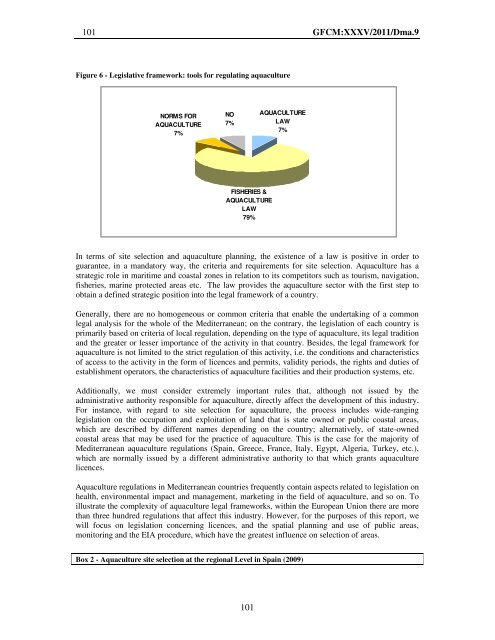Site selection and carrying capacity in Mediterranean ... - FAO Sipam
Site selection and carrying capacity in Mediterranean ... - FAO Sipam
Site selection and carrying capacity in Mediterranean ... - FAO Sipam
You also want an ePaper? Increase the reach of your titles
YUMPU automatically turns print PDFs into web optimized ePapers that Google loves.
101 GFCM:XXXV/2011/Dma.9<br />
Figure 6 - Legislative framework: tools for regulat<strong>in</strong>g aquaculture<br />
NORMS FOR<br />
AQUACULTURE<br />
7%<br />
NO<br />
7%<br />
FISHERIES &<br />
AQUACULTURE<br />
LAW<br />
79%<br />
In terms of site <strong>selection</strong> <strong>and</strong> aquaculture plann<strong>in</strong>g, the existence of a law is positive <strong>in</strong> order to<br />
guarantee, <strong>in</strong> a m<strong>and</strong>atory way, the criteria <strong>and</strong> requirements for site <strong>selection</strong>. Aquaculture has a<br />
strategic role <strong>in</strong> maritime <strong>and</strong> coastal zones <strong>in</strong> relation to its competitors such as tourism, navigation,<br />
fisheries, mar<strong>in</strong>e protected areas etc. The law provides the aquaculture sector with the first step to<br />
obta<strong>in</strong> a def<strong>in</strong>ed strategic position <strong>in</strong>to the legal framework of a country.<br />
Generally, there are no homogeneous or common criteria that enable the undertak<strong>in</strong>g of a common<br />
legal analysis for the whole of the <strong>Mediterranean</strong>; on the contrary, the legislation of each country is<br />
primarily based on criteria of local regulation, depend<strong>in</strong>g on the type of aquaculture, its legal tradition<br />
<strong>and</strong> the greater or lesser importance of the activity <strong>in</strong> that country. Besides, the legal framework for<br />
aquaculture is not limited to the strict regulation of this activity, i.e. the conditions <strong>and</strong> characteristics<br />
of access to the activity <strong>in</strong> the form of licences <strong>and</strong> permits, validity periods, the rights <strong>and</strong> duties of<br />
establishment operators, the characteristics of aquaculture facilities <strong>and</strong> their production systems, etc.<br />
Additionally, we must consider extremely important rules that, although not issued by the<br />
adm<strong>in</strong>istrative authority responsible for aquaculture, directly affect the development of this <strong>in</strong>dustry.<br />
For <strong>in</strong>stance, with regard to site <strong>selection</strong> for aquaculture, the process <strong>in</strong>cludes wide-rang<strong>in</strong>g<br />
legislation on the occupation <strong>and</strong> exploitation of l<strong>and</strong> that is state owned or public coastal areas,<br />
which are described by different names depend<strong>in</strong>g on the country; alternatively, of state-owned<br />
coastal areas that may be used for the practice of aquaculture. This is the case for the majority of<br />
<strong>Mediterranean</strong> aquaculture regulations (Spa<strong>in</strong>, Greece, France, Italy, Egypt, Algeria, Turkey, etc.),<br />
which are normally issued by a different adm<strong>in</strong>istrative authority to that which grants aquaculture<br />
licences.<br />
Aquaculture regulations <strong>in</strong> <strong>Mediterranean</strong> countries frequently conta<strong>in</strong> aspects related to legislation on<br />
health, environmental impact <strong>and</strong> management, market<strong>in</strong>g <strong>in</strong> the field of aquaculture, <strong>and</strong> so on. To<br />
illustrate the complexity of aquaculture legal frameworks, with<strong>in</strong> the European Union there are more<br />
than three hundred regulations that affect this <strong>in</strong>dustry. However, for the purposes of this report, we<br />
will focus on legislation concern<strong>in</strong>g licences, <strong>and</strong> the spatial plann<strong>in</strong>g <strong>and</strong> use of public areas,<br />
monitor<strong>in</strong>g <strong>and</strong> the EIA procedure, which have the greatest <strong>in</strong>fluence on <strong>selection</strong> of areas.<br />
Box 2 - Aquaculture site <strong>selection</strong> at the regional Level <strong>in</strong> Spa<strong>in</strong> (2009)<br />
101<br />
AQUACULTURE<br />
LAW<br />
7%
















